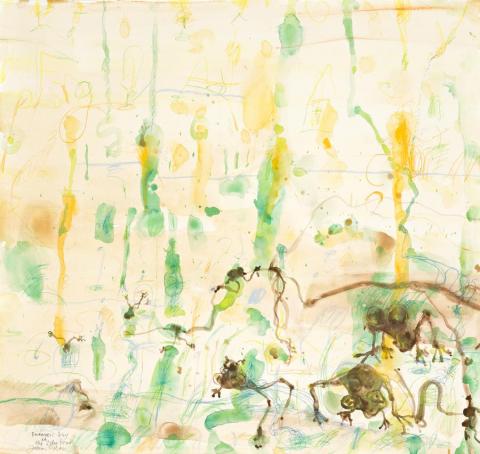SUMMER DAY AT THE LILY POND
JOHN OLSEN
watercolour and pastel on paper
94.5 x 99.5 cm
signed and inscribed lower left: Summer Day / at / the Lily Pond / John Olsen
Australian Art Resources, Melbourne
Private collection, Melbourne
It was during a number of engaging visits to North Queensland in the 1970s and 80s that John Olsen conceived what was to be an obsession with the jewel-like world of the lily pond. As noted by author Deborah Hart, 'Olsen wanted the viewer to see 'the microcosm and at the next moment the expansiveness of the universe.' Olsen later summed up his feeling about these environments:
'Working on these projects really altered my way of looking at these things because I could see note only bird-life but a whole range of biology. It is so staggeringly fragile. You have to have the estuaries and the waterlands to have the birds, the frogs, the crustaceans. In David Attenborough's film series he indicated that life really began in the water and after thousands of years creatures left the water. There is - still in those beautiful lily ponds that whole kind of structure that is the beginning of life. It just bourgeons itself in tropical countries.'1
The particular agility and crazy articulation of frogs was to be an enduring passion with Olsen filling notebooks at the time with sketches. Here in Summer Day at the Lily Pond they leap and tumble whilst all about the wash and pastel forms dabbled pools. A reflective experience, Olsen would recall such periods of creation as amongst his most positive, noting in his journal, 'A fruitful morning, working quietly at the lily pond, drinking in nature's grace. The pond is the largest I have seen - white lilies stretching for over a mile - scores of jacanas spreading their huge feet on lily pads, the Christ bird, walking on water. Immaculate white egrets dabbing sword-like beaks into the oozy mud. The writhing serpentine neck of the darter as it hangs its wings out to dry like Monday's washing. Struggling to arrive at the proper abstracting, amongst the variations that nature contrives.'2
1. Hart., D., John Olsen, Craftsman House, Sydney, 1991, p. 129
2. Olsen, J., Drawn from Life, Duffy and Snellgrove, Sydney, 1997, p. 253
MERRYN SCHRIEVER
